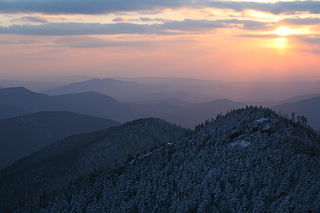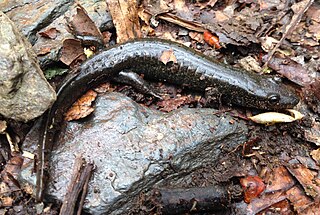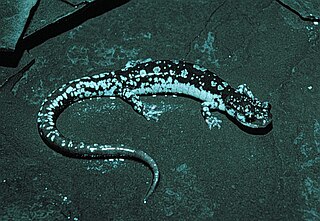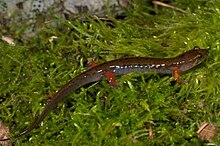
The Great Smoky Mountains are a mountain range rising along the Tennessee–North Carolina border in the southeastern United States. They are a subrange of the Appalachian Mountains and form part of the Blue Ridge Physiographic Province. The range is sometimes called the Smoky Mountains, and the name is commonly shortened to the Smokies. The Smokies are best known as the home of the Great Smoky Mountains National Park, which protects most of the range. The park was established in 1934 and, with over 11 million visits per year, is the most visited national park in the United States.

The Cheat Mountain salamander is a species of small woodland salamander found only on Cheat Mountain, and a few nearby mountains, in the eastern highlands of West Virginia. It and the West Virginia spring salamander are the only vertebrate species with geographic ranges restricted to that state.
The Cumberland dusky salamander is a species of salamander in the family of lungless salamanders, Plethodontidae. It is endemic to the United States. Its natural habitats are temperate forests and rivers. This species is threatened by habitat loss.

The seepage salamander is a small, terrestrial species of salamander in the family Plethodontidae. It is endemic to the United States. They are found in small areas of Tennessee, North Carolina, Georgia, and Alabama. Its natural habitats are temperate forests, intermittent rivers, and freshwater springs. It gets its name from the seepages around which it lives. It is very similar in its appearance and life history to the pygmy salamander. These two species differ greatly from the other Desmognathus species. They are the smallest salamanders in the genus, measuring only 3–5 cm (1–2 in) in length. They are also the only two terrestrial, direct-developing Desmognathus species. However, the two species are not often seen to coexist, differing in distribution by elevation; although there are exceptions. The seepage salamander is currently listed as Near Threatened, with its numbers declining in most of states in which it is found. It is threatened by habitat loss, with logging having a major effect.

Desmognathus fuscus is a species of amphibian in the family Plethodontidae. The species is commonly called the dusky salamander or northern dusky salamander to distinguish it from populations in the southern United States which form several distinct species, the southern dusky salamanders. The northern dusky salamander is the most widespread representative of its genus in Canada. It can be found in eastern North America from extreme eastern Canada in New Brunswick south to South Carolina. The size of the species' total population is unknown, but is assumed to easily exceed 100,000. The species' habitat differs somewhat geographically; dusky salamanders in the northern part of the range prefer rocky woodland streams, seepages, and springs, while those in the south favor floodplains, sloughs, and muddy places along upland streams. They are most common where water is running or trickling. They hide under various objects, such as leaves or rocks, either in or near water. Alternatively, they may enter burrows for protection. The dusky salamander lays its eggs close to water under moss or rocks, in logs, or in stream-bank cavities. The larval stage which follows is normally aquatic.

The shovelnose salamander is a species of salamander in the family Plethodontidae. It is endemic to the United States.

The seal salamander is a species of lungless salamander that is endemic to the Eastern United States.

The ocoee salamander is a species of salamander in the family Plethodontidae. This salamander has a variety of colors and patterns, and got its name from Tennessee state wildflower. Its natural habitats are temperate forests, rivers, intermittent rivers, freshwater springs and wet rocks in mountainous areas of the Southeastern United States. It was first described by Nicholls in 1949. They are territorial and feed on small invertebrates. It is widely distributed in the southeastern United States and is listed as "Least Concern" by the International Union for Conservation of Nature.
The Blue Ridge dusky salamander is a species of salamander in the family Plethodontidae.

The blackbelly salamander is a species of salamander in the family Plethodontidae. It is endemic to the United States. Its natural habitats are rivers, intermittent rivers, and freshwater springs. It is threatened by habitat loss.
The black mountain salamander is a species of salamander in the family Plethodontidae.

The pygmy salamander is a species of salamander in the family Plethodontidae. It is endemic to the United States in the southern Appalachians in North Carolina and Tennessee. Desmognathus wrighti is a member of the family Plethodontidae and is commonly known as the pygmy salamander. As the name suggest the pygmy salamander is the smallest of the nineteen species in the genus Desmognathus. D. wrighti undergoes direct development and does not have a free-living larval stage. Only two other taxa in Desmognathus, D. aeneus and D. organi, exhibit direct development along with the pygmy salamander. In the genus Desmognathus, body size, habitat preferences, and patterns used by males during courtship are quite variable. D. wrighti courtship is noted by the male biting and seizing its partner in order to provide them with a chemical stimulus. The pygmy salamander can be found in the southern Appalachians of the United States in western North Carolina and eastern Tennessee. Geographical distribution of the Desmognathus wrighti is fragmented and the highest abundance of the species can be found at high elevations in spruce and fir tree forest.

The Junaluska salamander is a species of lungless salamander native to the south-eastern United States. It was first described by David M. Sever, Harold M. Dundee, and Charles D. Sullivan who found the species in the range from the Cheoah River, Santeetlah Creek, and Tululah Creek in Graham County of North Carolina. Adults of this species can be found near large, rocky streams and on rainy nights on roads in the areas specified. The salamander is characterized by brownish-yellow coloration with a series of small dots along the body and a robust build compared to the other salamanders in Eurycea. The Junaluska salamander's breeding habits tend to be in large streams where the eggs are laid and attached to the bottom of rocks in the streams where they are found. According to the overall conservation listing for IUCN, this species is listed as Vulnerable. Conservation acts are important in both North Carolina and Eastern Tennessee, since the population of this species in each state is so small.

The spring salamander is a species of salamander in the family Plethodontidae. It is found in Canada and the United States. The genus, Gyrinophilus, means "tadpole lover" and refers to the long period of time it spends as a gilled larva before maturing. The specific epithet, porphyriticus, is Latin from Greek, meaning the color of porphyry, a purple stone, and this salamander has also been called the purple salamander.

The Fourche Mountain salamander is a species of salamander in the family Plethodontidae endemic to the Ouachita Mountains in the central United States. Its natural habitat is temperate forests and it is threatened by habitat loss.

The red-cheeked salamander, also known as the Jordan's salamander, Jordan's redcheek salamander, or Appalachian woodland salamander, is a species of salamander in the family Plethodontidae. It is endemic to the Appalachian Mountains in the southeastern United States.

The green salamander is a species of lungless salamander in the family Plethodontidae. It and the Hickory Nut Gorge green salamander are the only currently-described members of the genus Aneides that inhabit any areas in the eastern half of United States. Rarely seen in the field, the green salamander is an extremely habitat-specific species that is seldom found away from its preferred surroundings: moist, shaded rock crevices.

The northern pygmy salamander is a terrestrial species of salamander in the family Plethodontidae and genus Desmognathus. Along with the southern pygmy and the seepage salamander, these are some of the smallest salamander species in North America and can be found in higher elevations in the southern Appalachians.

















